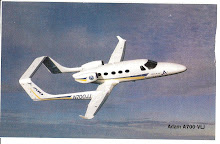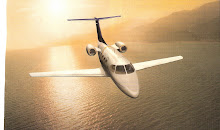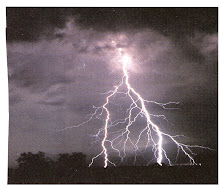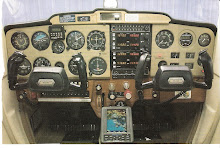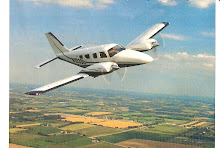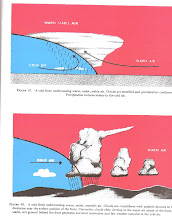Hi Readers: Did you know that you can tell how far away a thunderstorm is from your position? Follow the lightning you see, count the seconds until you hear thunder. Then multiply your seconds times 1,128 - the speed of sound in ft/sec.
Moving on to Wind Shear. The subject, not all that well known to pilots and operators; and probably one of the most studied weather-related occurrences over the years, yet remaining highly misunderstood. In fact, the awareness factor is alarming. We have only to follow the thunderstorm and tornado reports, those originating from tropical air in the Southwest moving across the South and Midwest of the U.S., and the increased frequency of these storms in the past several years to find the source of our wind shear. Not that it doesn't occur in other areas of the world.
Wind shear is one of the more important weather-related occurrences, convective-type initiations; separate and distinct from known air turbulence, wake turbulence, mountain wave, jetwash, etc., that we should be aware of and include in our flight planning. Wind shear is directly related to downdrafts, microbursts, and convective vortex movements of air. The simple definition of wind shear is a sudden, drastic shift in winds speed, direction, or both in a horizontal and vertical plane. It's dangerous at any altitude, and particularly during surface operations such as approach, landing and takeoff. It can happen in airline or GA operations, VFR or IFR conditions, notably in connection with a cumulo-nimbus cloud or a thunderstorm.
Our cognizance of the hazards of wind shear must become full blown - the suddenness, the safety, and the fatal aspects are alarming; and the size and extent of the hazards are strictly after the fact.
Let's start with the accepted fact that wind shear per se is hazardous and dangerous to flight by fact and experience. And, by nature, it is associated with convective air movements such as a thunderstorm, a cumulo-nimbus cloud, rain, a snowstorm, and downdrafts producing a microburst of air which sets up the wind shear and ends in a general flattening to the surface with vortex movements at each end. The total effects to airplane control are not instantaneous and can continue and progress from one stage to another; such as an increase or decrease of windspeed, which affects the airplane airspeed, and causes pitch control problems. The wind shear, as analyzed, is actually the result of the strong downdraft of air out of the center of the storm, called the rainshaft (rain or virga). This downdraft, or microburst of air, contacting the surface, then spreads out as much as 5 miles or more, horizontally and vertically, terminated by inward and upward moving vortices ( as explained before). It is estimated that 5% of all thunderstorms produce a microburst.
Indications in the cockpit to detect the microburst and wind shear seem to be the sudden airspeed variation, and the amount, a sudden pitch change, heavy turbulence, and a tendency to yaw or roll. The extent of the occurrence is, of course, unpredictable.
Airline encounters of wind shear have been on approach to land, landing, and takeoff. The typical approach occurrence is best illustrated by a 1985 encounter by Delta Air Lines, Flt 191, an L-1011 airplane, approaching the Dallas-Ft.Worth Intl airport, flying through a thunderstorm rainshaft, in which the developing microburst forced a landing short of the runway, resulting in fire and fatalities.
In another occurrence in 1999, American Air Lines Flt 1420, in attempting a landing at night at Little Rock, Arkansas, flew into a severe thunderstorm and crosswind, losing complete control. Similar circumstances to the Delta encounter occurred.
The typical takeoff and climb situations, encountering a microburst, resulting in wind shear, have similar cockpit indications, pitch control problems, and prevention of adequate climb past the runway.
Wind Shear - PartII will follow with Analysis.
Friday, September 28, 2007
Monday, September 17, 2007
July - August 2007 Aircraft Accidents
Hi Readers: Back from the hospital - a huge bit of vertigo and a spiking blood pressure caught me unawares. Now I'll finish what I started. Looks like July and August 2007 were two months of aircraft accidents and incidents indicating some very bad judgment and failure to follow the rules. The weather played a part, too. NTSB is still investigating.
There were 72 aircraft accidents and 5 incidents in August compared to 199 accidents and 3 incidents in July. The fatal accidents in August totaled 26, with 55 fatalities, compared to 39 fatal accidents, with 73 fatalities (not including the Brazilian airline fiasco, taking 186 lives) in July.
The record for August indicates an improvement until we look at the type and nature of the accidents. And, as we go along, we'll keep in mind the question, "could these accidents and incidents have been prevented?". Although it will take a detailed study and review to know why and how, the answer, of course, is a resounding yes.
The flying hours for each month, which at this point would still be estimated, would indicate a slight increase in the accident rate. The incidents and the fatal accidents, however, give us the insight that we need, since the incident is the beginning of an accident and the fatal accident has reached and passed its reality.
Without going into the details, both the July and August incidents indicated pilot error, local and ground control errors, as well as poor coordination in the taxi, takeoff, and landing operations. All of the operations occured in daylight and during VFR conditions.
The July and August accidents occured worldwide, with the majority being in the continental U.S., with Alaska accounting for 8 accidents in July and 11 accidents in August.
The fatal accidents, particularly in Alaska, are revealing of multiple errors:
Weather Involved: July 2007 - 9 , August 2007 - 4
Pilot Error (Loss of control, etc.): Jul - 13 ; Aug 9
Engine Failure: Jul - 1 ; Aug 2
Experimental / Amateur failures: Jul 1 ; Aug - 5
Unknown / Unreported: Jul - 10 ; Aug - 2
Inflight Fire: Jul 1 ; Aug - 0
Medical Flight: Jul - 1 ; Aug - 1
Suicide: Jul - 0 ; Aug - 1
Uncertificated Flight: Jul - 0; Aug - 1
Helicopter tail rotor failure: Jul - 1 ; Aug - 1
Helicopter collision: Jul - 1 ; Aug - 0
The collision of 2 TV Channel news helicopters in Phoenix, AZ while watching a police persuit on the ground, as unusual as it was, showed inattention in flight and poor coordination of operations (in fact there were a total of five helicopters in the air in the same operation).
There were two fatal Part 135 sightseeing tour accidents out of Ketchikan, Alaska, one in July and one in August, both DeHavilland DHC-2 aircraft. Both directly involving VFR operations in IFR conditions of rain, fog, low clouds, and strong downdrafts. The July accident resulted in 5 fatalities and 4 serious injuries, and the August accident in 5 fatalities.
We will hope for better results in September. Thanks for listening.
RS
There were 72 aircraft accidents and 5 incidents in August compared to 199 accidents and 3 incidents in July. The fatal accidents in August totaled 26, with 55 fatalities, compared to 39 fatal accidents, with 73 fatalities (not including the Brazilian airline fiasco, taking 186 lives) in July.
The record for August indicates an improvement until we look at the type and nature of the accidents. And, as we go along, we'll keep in mind the question, "could these accidents and incidents have been prevented?". Although it will take a detailed study and review to know why and how, the answer, of course, is a resounding yes.
The flying hours for each month, which at this point would still be estimated, would indicate a slight increase in the accident rate. The incidents and the fatal accidents, however, give us the insight that we need, since the incident is the beginning of an accident and the fatal accident has reached and passed its reality.
Without going into the details, both the July and August incidents indicated pilot error, local and ground control errors, as well as poor coordination in the taxi, takeoff, and landing operations. All of the operations occured in daylight and during VFR conditions.
The July and August accidents occured worldwide, with the majority being in the continental U.S., with Alaska accounting for 8 accidents in July and 11 accidents in August.
The fatal accidents, particularly in Alaska, are revealing of multiple errors:
Weather Involved: July 2007 - 9 , August 2007 - 4
Pilot Error (Loss of control, etc.): Jul - 13 ; Aug 9
Engine Failure: Jul - 1 ; Aug 2
Experimental / Amateur failures: Jul 1 ; Aug - 5
Unknown / Unreported: Jul - 10 ; Aug - 2
Inflight Fire: Jul 1 ; Aug - 0
Medical Flight: Jul - 1 ; Aug - 1
Suicide: Jul - 0 ; Aug - 1
Uncertificated Flight: Jul - 0; Aug - 1
Helicopter tail rotor failure: Jul - 1 ; Aug - 1
Helicopter collision: Jul - 1 ; Aug - 0
The collision of 2 TV Channel news helicopters in Phoenix, AZ while watching a police persuit on the ground, as unusual as it was, showed inattention in flight and poor coordination of operations (in fact there were a total of five helicopters in the air in the same operation).
There were two fatal Part 135 sightseeing tour accidents out of Ketchikan, Alaska, one in July and one in August, both DeHavilland DHC-2 aircraft. Both directly involving VFR operations in IFR conditions of rain, fog, low clouds, and strong downdrafts. The July accident resulted in 5 fatalities and 4 serious injuries, and the August accident in 5 fatalities.
We will hope for better results in September. Thanks for listening.
RS
Labels:
accidents,
air travel,
Airline pilots,
airlines,
August 2007,
Aviation careers,
cargo,
flying hours,
forecasts,
incident,
July 2007,
NTSB,
pilot error
Wednesday, September 5, 2007
CTAF and UNICOM
Hi readers: There has always been a certain amount of confusion regarding CTAF and UNICOM as to purpose, use, and where to find the information on both. Well, it has to do with in and out traffic and flight safety at and in the vicinity of airports operating without a control tower.
Why is this so important? It is essential that all pilots be aware of and communicate with other traffic when approaching, departing, and in the vicinity of an airport without a tower since all the aircraft may not have a communications ability. To achieve the highest degree of safety, all of the radio-equipped aircraft must transmit and receive on a common frequency for advisories. CTAF (Common Traffic Advisory Frequency) is the frequency that must be used for this purpose. The CTAF's for each airport are listed on aeronautical charts or in the FAA Airport Facility Directory or in other appropriate publications. The CTAF can be obtained by contacting any FSS (Flight Service Station), and you can communicate on a UNICOM frequency or a published CTAF.
What is UNICOM? UNICOM is a nongovernmental air/ground radio communications station which may provide airport information for public use airports where there is no tower or FSS. UNICOM stations provide pilots (on request) with weather information, wind direction, the recommended runway, and other necessary information. If the UNICOM frequency is designated as the CTAF, it will be be identified in the appropriate aeronautical publication.
If an airport has a tower and it is temporarily closed or operated on a part-time basis and there is no FSS on the airport or the FSS is closed, then the pilot must announce his position and intentions on the CTAF. Where there is no tower, FSS, or UNICOM station on the airport, a MULTICOM frequency of 122.9 is used for self-announce procedures. If there is no tower, but a FSS is open, you can communicate with the FSS on the CTAF. In retrospect, the CTAF may be a UNICOM, MULTICOM, FSS, or tower frequency, which all can be found in the aforementioned directory.
There are established, recommended traffic advisory practices in FAR, Chapter 4: Air Traffic Control, that pilots should note and use.
CTAF and UNICOM are very important, also, to all pilots in flight since an emergency can always occur and the need to communicate with an airport becomes very necessary.
Why is this so important? It is essential that all pilots be aware of and communicate with other traffic when approaching, departing, and in the vicinity of an airport without a tower since all the aircraft may not have a communications ability. To achieve the highest degree of safety, all of the radio-equipped aircraft must transmit and receive on a common frequency for advisories. CTAF (Common Traffic Advisory Frequency) is the frequency that must be used for this purpose. The CTAF's for each airport are listed on aeronautical charts or in the FAA Airport Facility Directory or in other appropriate publications. The CTAF can be obtained by contacting any FSS (Flight Service Station), and you can communicate on a UNICOM frequency or a published CTAF.
What is UNICOM? UNICOM is a nongovernmental air/ground radio communications station which may provide airport information for public use airports where there is no tower or FSS. UNICOM stations provide pilots (on request) with weather information, wind direction, the recommended runway, and other necessary information. If the UNICOM frequency is designated as the CTAF, it will be be identified in the appropriate aeronautical publication.
If an airport has a tower and it is temporarily closed or operated on a part-time basis and there is no FSS on the airport or the FSS is closed, then the pilot must announce his position and intentions on the CTAF. Where there is no tower, FSS, or UNICOM station on the airport, a MULTICOM frequency of 122.9 is used for self-announce procedures. If there is no tower, but a FSS is open, you can communicate with the FSS on the CTAF. In retrospect, the CTAF may be a UNICOM, MULTICOM, FSS, or tower frequency, which all can be found in the aforementioned directory.
There are established, recommended traffic advisory practices in FAR, Chapter 4: Air Traffic Control, that pilots should note and use.
CTAF and UNICOM are very important, also, to all pilots in flight since an emergency can always occur and the need to communicate with an airport becomes very necessary.
Labels:
air travel,
Airline pilots,
airlines,
airports,
Aviation careers,
cargo,
CTAF,
FARs,
flight safety,
flying hours,
forecasts,
frequency,
FSS,
no tower,
traffic delay,
UNICOM
Subscribe to:
Comments (Atom)

